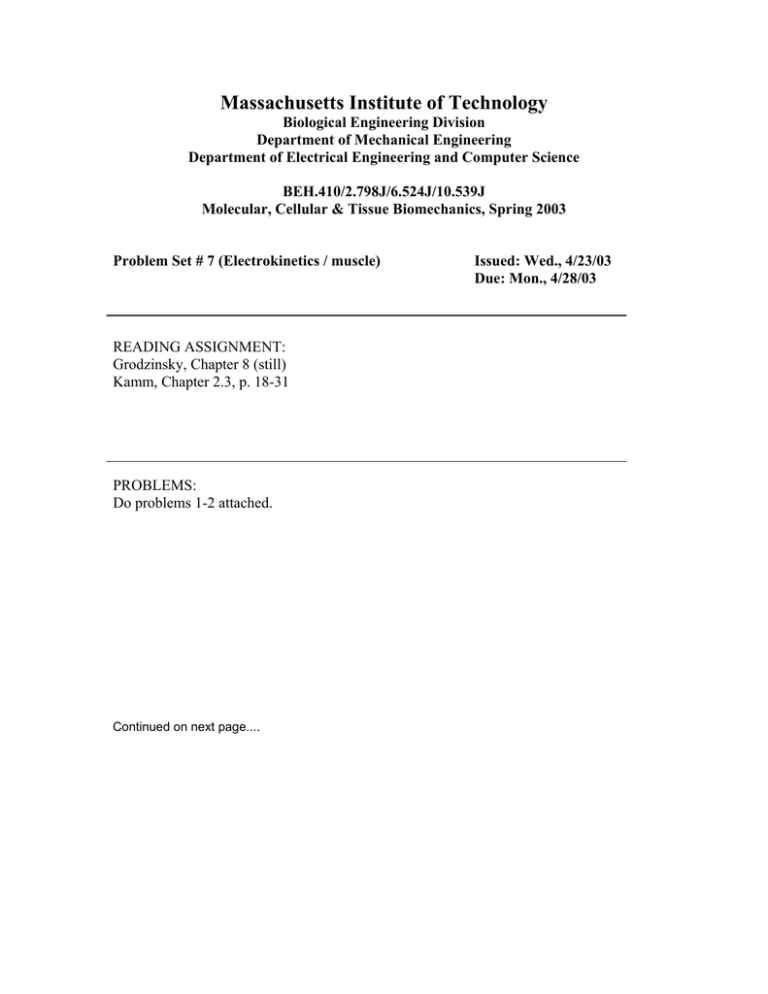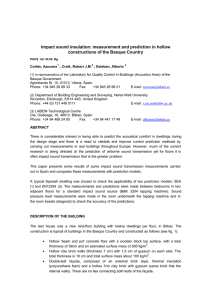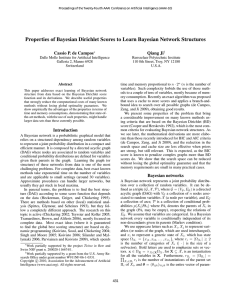Massachusetts Institute of Technology
advertisement

Massachusetts Institute of Technology Biological Engineering Division Department of Mechanical Engineering Department of Electrical Engineering and Computer Science BEH.410/2.798J/6.524J/10.539J Molecular, Cellular & Tissue Biomechanics, Spring 2003 Problem Set # 7 (Electrokinetics / muscle) READING ASSIGNMENT: Grodzinsky, Chapter 8 (still) Kamm, Chapter 2.3, p. 18-31 PROBLEMS: Do problems 1-2 attached. Continued on next page.... Issued: Wed., 4/23/03 Due: Mon., 4/28/03 Problem 1: Electromechanical Interactions in Charged Poroelastic Tissue A tissue specimen in the form of a cylindrical disk of thickness L is placed in the radially confining geometries of Fig. 1 and Fig. 2, in a buffer of 0.15 Molar NaCl. Assume that the tissue can be modeled as a hydrated, linear, isotropic, homogeneous matrix having negative fixed charge groups. U = U0 D Tissue p = P0 p=0 x1 = L x1 Fig. 1 + V - a) Write the 1-dimensional equations of motion that describe the response of the tissue to mechanical or electrical stimuli in any experimental configuration. These equations include (i) conservation of momentum, (ii) conservation of mass, (iii) a stress-strain constitutive law, (iv-v) constituve laws for relative fluid velocity and electrical current density caused by pressure and voltage gradients (expressed in terms of the coupling coefficients kij, and (vi) conservvation of current. You can assume that the kij are known positive-definite constants obtained from independent measurements. (Do not solve the equations yet.) b) Using the configuration of Fig. 1, a steady state pressure drop is applied across the tissue, resulting in steady fluid velocity U0. The porous electrodes on both sides of the tissue allow fluid to move freely across the tissue and hold the tissue in place. Assume that the fluid flow U0 does NOT affect the tissue’s hydraulic permeability. (i) Wiith the elctrodes shorted together such that the voltage drop across the tissue is zero (V = 0), find an expression for the tissue’s hydraulic permeability in terms of one or more of the kij. (ii) With the electrodes left “open circuited” so that the current density J across the tissue is zero, find a new expression for the tissue’s effective hydraulic permeability in terms of one or more of the kij. c) Now combine the equations of motion from part (a) to obtain a single differential equation for the displacement u1(x1,t) in terms of material parameters (modulus, kij) and including terms that account for the possibility of a constant fluid velocity U0 and a constant current density J0 flowing across the tissue in steady state. d) In Fig. 2, the porous electrode platen at x1 = 0 is glued to the tissue and held fixed in space such that u1 = 0 at the boundary x1 = 0. In addition, u1 = 0 at x1 = L. A steady current density J0 is applied across the tissue by means of the electrodes. Find an expression for the steady state displacement u1(x1) within the tissue caused by the applied current. From you answer, find an expression for the “current generated stress” σ11 at x1 = 0. Sketch the displacement u1(x1) versus x1, and briefly describe how the current causes this displacement profile. x1 = 0 + J0 _ x1 = L x1 Fig. 2 Problem 2 – Cross-bridge model The cross-bridge model presented in class and in the notes presents the basic conceepts, but is obviously idealized. Over the years, researchers have proposed various functional forms for the binding and unbinding rate constants (k+ and k-, respectively). Here we explore one of those alternative descriptions in which k- rises linearly for x < 0 with a slope of -α (see figure). a) Drawing upon all the same assumptions as in the model presented in class, changing only the x-dependence of the unbinding rate constant as shown, obtain new expressions for the binding probability, n(x), in each of the domains, the normalized force generated per unit area, F/Fmax [like in eqn (34) in Chapter 2.3, assume x0 << h], and the normalized power, (Fv)/(Fmaxvmax). rate constants k+ k− x0 x=h x b) Plot n(x) for several different values of sliding velocity. Explain the observed behavior in terms of the maximum values attained and the length of the asymptotic tail in the range of x < 0. c) Identify parameter values that produce a normalized force-velocity curve as obtained in (a) that agrees with Hill’s equation v v max 1 − (F Fmax ) = 1 + C(F Fmax ) [see eqn. (20) in Chapter 2.3] with C = 5. Plot both relationships [v/vmax as a function of F/Fmax] on the same graph. (There’s no need match the two extremely well, I just want you to see how the different parameter values affect the curves.) d) Describe in qualitative terms, the effect on n(x) of having a large value for kimmediately as x falls below zero (you can consider this in the context of the model presented in class with constant k- for x < 0) . Explain how this would affect the power that can be generated by the muscle or the efficiency of power generation.







